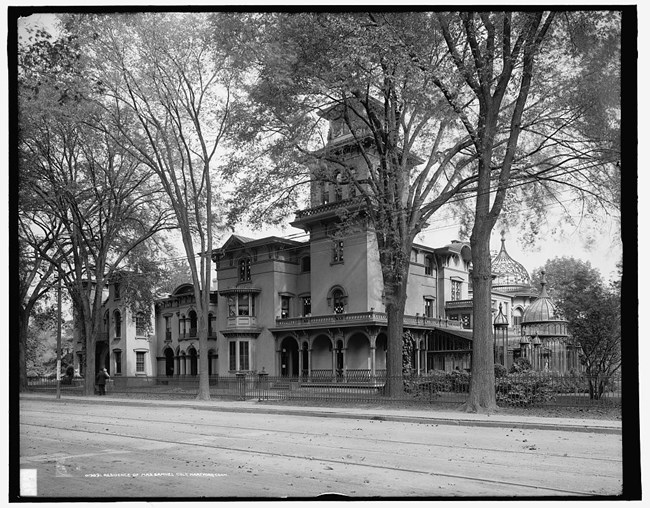|
Armsmear is a private residence and not open to the public. Please be respectful of the current residents.

Photo Credit: Connecticut State Library/R.S. DeLamater Overlooking Colt Park and Colt’s Patent Firearms Manufacturing Company, Armsmear, on Wethersfield Avenue, is the family home of Samuel Colt and Elizabeth Hart Jarvis Colt. Meaning “the meadow of arms,” Armsmear became a lasting symbol, sitting atop a meadow overlooking the firearms factory, of family and community. "This house, when it was one home, was a place of family worship.”
Armsmear is an Italianate Villa with Moorish Elements; a design that was inspired by the Colt’s travels in the East, being Turkey, Iran, France and Great Britain. Prior to the Civil War, it was considered to be one of the grandest and exotic residences in the United States.

Photo Credit: NPS The residence, when originally constructed, had an ogee dome, similar to that of the one on the East Armory, three towers and elaborate glass conservatories. With its irregular design of two-and three-story blocks, rectangular and arched windows framed in by brownstone and balconies, Armsmear was a marketing call for Samuel Colt, much like the Blue Onion Dome. It was a state-of-the-art building at the time, including gas lighting, a plumbing system, and numerous clear paned glass windows. A pair of Uffizi Dogs, replicas of ones from Rome’s Hellenistic Period, guarded the front door and still do today. In decorating the interior of Armsmear, Samuel commissioned Ringuet-LePrince & Marcotte, a firm that had offices in New York and Paris. In selecting this firm, Samuel ensured that his furnishings would have a worldly feel. The house was exquisitely decorated with numerous chandeliers, pieces of furniture specifically designed for the Colts, and custom rugs, carpets and curtains. Samuel and Elizabeth were both involved in the design process, often making suggestions. Even while spending thousands of dollars to furnish the house, Samuel was budget conscious and questioned from time to time why some items were billed higher than the original estimate. Throughout the lives of the Colts, Armsmear was a gathering place for family and friends. Parties were held on the grounds, including Caldwell’s 21st birthday, numerous philanthropic meetings, and gatherings for Colt Armory employees. After Samuel’s passing, Elizabeth reimagined the public rooms of Armsmear. The ballroom became a private art gallery and a reception room replaced the music room. Elizabeth continued to add to her private art collection until her passing, giving Armsmear an eclectic, worldly feel. 
Photo Credit: NPS The philanthropic mission of Elizabeth continued even after her death as Armsmear became a residence for senior women of faith with limited income and assets. It underwent renovations to create separate apartments, offices, and a chapel before it opened in 1911 after delays in the construction. Elizabeth funded the Elizabeth Hart Jarvis Colt Memorial Wing in the Wadsworth Atheneum Museum of Art, which was the first wing in an America municipal museum to be named for a woman. Many of the possessions acquired throughout the Colt's travels and personal possessions were bequeathed to the Museum and are periodically on display. Armsmear has undergone many changes, but it still maintains the spirit of Elizabeth through its mission of service. In 1935 Armsmear was registered as a Historic Site through the Historic Sites Act and in 1966 it was designated as a National Historic Landmark. In 2008 it became a contributing building to the Coltsville Historic District and is registered as a National Historic Landmark. In 2014, the U.S. Congress authorized creation of the Coltsville National Historical Park. 
Library of Congress, Prints & Photographs Division/Detroit Publish Company “The thought must be in the minds of all of us today that Armsmear has entered upon a career of usefulness which will continue for many generations.” Reverend George T. Linsley, The Hartford Courant, January 8th, 1912 |
Last updated: April 7, 2021
